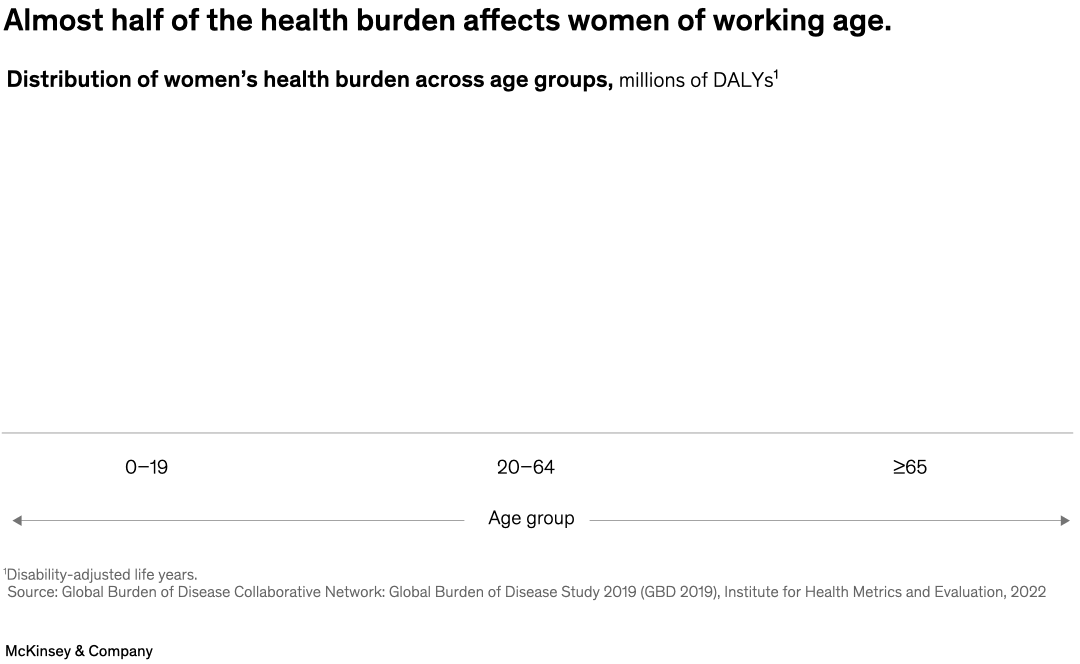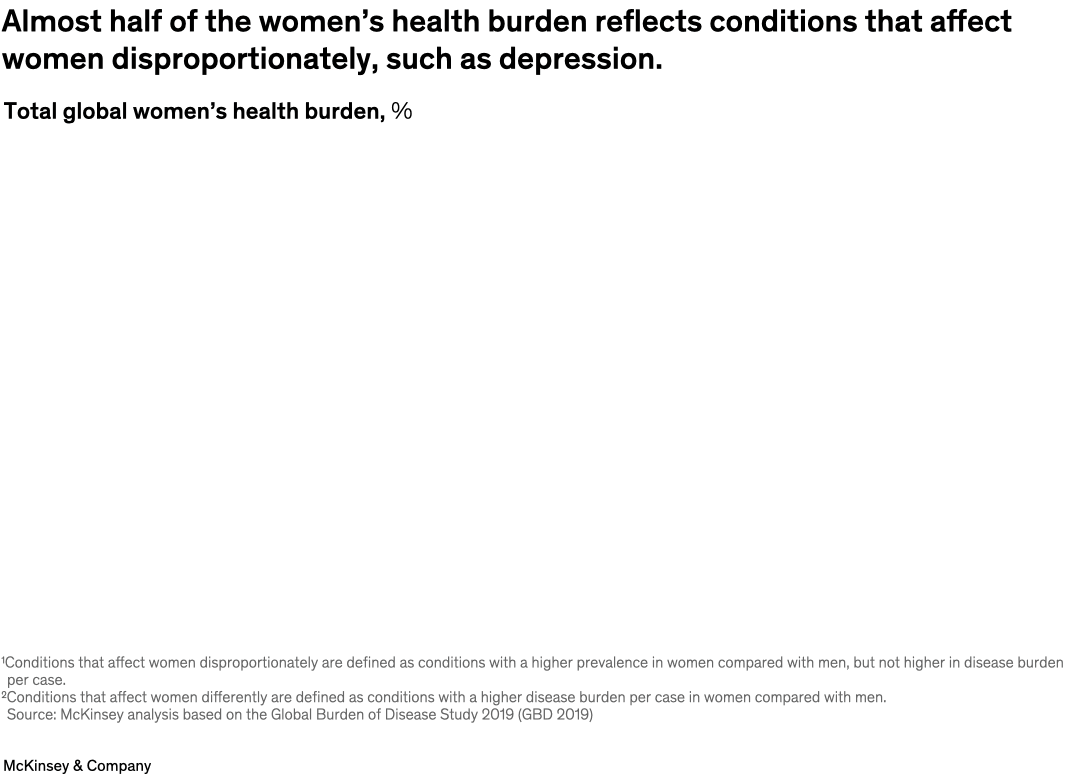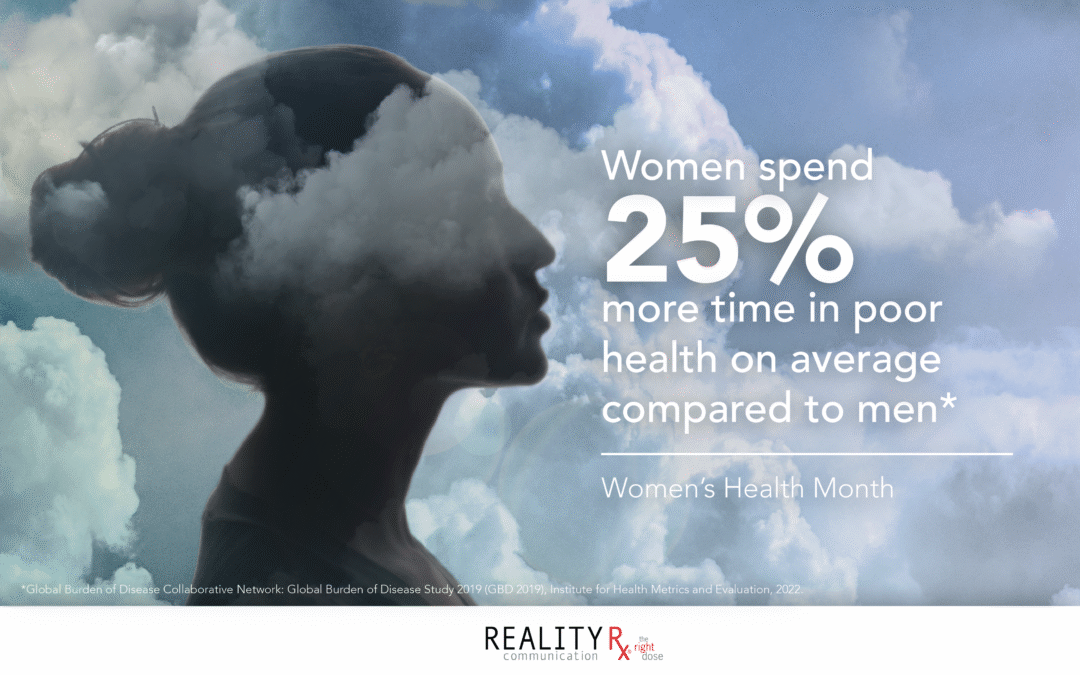There’s a big difference between a women’s life span and her ‘health span,” which is her healthy years minus her years of poor health and disability. Most women will spend about nine years of their lives in poor health, impacting their ability to work and overall quality of life. This is in contrast to men’s health spans, which average about 25% less time in poor health compared with women.
Much of the heath gap for women occurs not during retirement, but during the critical working years, which can significantly reduce their earning potential. Decreasing amount of time women are in poor health would allow them to remain in the workforce. This could help lift some women out of poverty and enable many more to provide for themselves and their families.

Poor Health Impacts Women Disproportionately During Their Working Years

Source: McKinsey Health Institute
So what explains the health gap between women and men? To begin with, women’s health is often viewed through the lens of sexual and reproductive health (SRH), which greatly underrepresents women’s health burden. According to the National Institutes of Health, there are many health conditions that affect women differently (higher disease burden) or disproportionately (higher prevalence) that are not getting enough attention.

Clinical trials of pharmaceutical agents are not providing safety information that could indicate what medicines are more appropriate for women – because safety data is not broken down by sex and gender. According to the FDA Adverse Events Reporting System FAERS), starting in 2000 women report adverse events from approved medicines 52% more frequently than men, and serious or fatal events have occurred 36% more frequently. Healthcare professionals in the United States reported 4.4 million serious or fatal events for women – versus 3.8 million for men – through 2022.
In addition, new clinical trials are primarily focused on high mortality diseases, not the diseases that can increase disability. In the current pipeline of drugs being developed specifically for women, there are almost ten times as many therapies for the most common women’s cancers than for debilitating gynecological conditions. Both are critically important, and we need new therapies developed for other women’s health conditions—in particular, menopause, premenstrual syndrome, endometriosis, and polycystic ovary syndrome.

Source: McKinsey Health Institute
The women’s health gap can be closed by addressing the root causes of poor health, including: the lack of development of drugs to help reduce disability; the shortage of women-specific safety and efficacy data; and the lack of understanding of the causes and extent of women’s reduced health span by all stakeholders.
REALITYRx has extensive experience creating and implementing corporate campaigns for our clients. We become immersed in our client’s business challenges, understand the competitor’s strengths and weaknesses, and develop customer insights. From strategy to creative to execution, we can help you position and promote your brand to maximize sales. See examples of our client work here.
Reference: Ellingrud K, Pérez L, Petersen A, Sartori V. Closing the Women’s Health Gap: a $1 Trillion Opportunity to Improve Lives and Economies. https://www.mckinsey.com/mhi/our-insights/closing-the-womens-health-gap-a-1-trillion-dollar-opportunity-to-improve-lives-and-economies. Published January 17, 2024. Accessed May 28, 2025.
There’s a big difference between a women’s life span and her ‘health span,” which is her healthy years minus her years of poor health and disability. Most women will spend about nine years of their lives in poor health, impacting their ability to work and overall quality of life. This is in contrast to men’s health spans, which average about 25% less time in poor health compared with women.

Much of the heath gap for women occurs not during retirement, but during the critical working years, which can significantly reduce their earning potential. Decreasing amount of time women are in poor health would allow them to remain in the workforce. This could help lift some women out of poverty and enable many more to provide for themselves and their families.
Poor Health Impacts Women Disproportionately During Their Working Years

Source: McKinsey Health Institute
So what explains the health gap between women and men? To begin with, women’s health is often viewed through the lens of sexual and reproductive health (SRH), which greatly underrepresents women’s health burden. According to the National Institutes of Health, there are many health conditions that affect women differently (higher disease burden) or disproportionately (higher prevalence) that are not getting enough attention.

Clinical trials of pharmaceutical agents are not providing safety information that could indicate what medicines are more appropriate for women – because safety data is not broken down by sex and gender. According to the FDA Adverse Events Reporting System FAERS), starting in 2000 women report adverse events from approved medicines 52% more frequently than men, and serious or fatal events have occurred 36% more frequently. Healthcare professionals in the United States reported 4.4 million serious or fatal events for women – versus 3.8 million for men – through 2022.
In addition, new clinical trials are primarily focused on high mortality diseases, not the diseases that can increase disability. In the current pipeline of drugs being developed specifically for women, there are almost ten times as many therapies for the most common women’s cancers than for debilitating gynecological conditions. Both are critically important, and we need new therapies developed for other women’s health conditions—in particular, menopause, premenstrual syndrome, endometriosis, and polycystic ovary syndrome.

The women’s health gap can be closed by addressing the root causes of poor health, including: the lack of development of drugs to help reduce disability; the shortage of women-specific safety and efficacy data; and the lack of understanding of the causes and extent of women’s reduced health span by all stakeholders.
REALITYRx has extensive experience creating and implementing corporate campaigns for our clients. We become immersed in our client’s business challenges, understand the competitor’s strengths and weaknesses, and develop customer insights. From strategy to creative to execution, we can help you position and promote your brand to maximize sales. See examples of our client work here.
Reference: Ellingrud K, Pérez L, Petersen A, Sartori V. Closing the Women’s Health Gap: a $1 Trillion Opportunity to Improve Lives and Economies. https://www.mckinsey.com/mhi/our-insights/closing-the-womens-health-gap-a-1-trillion-dollar-opportunity-to-improve-lives-and-economies. Published January 17, 2024. Accessed May 28, 2025.

